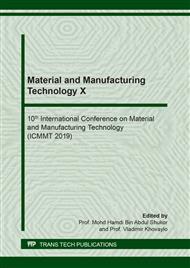p.176
p.181
p.189
p.194
p.199
p.204
p.209
p.214
p.223
Synthesis of Hydroxyapatite from Indonesian Green Mussels (Perna viridis) via Precipitation Methods
Abstract:
Based on the X-Ray Fluorescence test it was identified that the calcium content in green mussel shells was very high with concentration about 93.83%. The calcium is the main constituent of hydroxyapatite besides phosphorus, so the purpose of this study is to identify a very good potential for synthesized hydroxyapatite from green mussel shells, which is considered the waste of shells that cause environmental pollution. Hydroxyapatite synthesized from green mussels using precipitation method, calcium from green was reacted with phosphate obtained from phosphoric acid. The Fourier transform infrared spectrum show that the functional group in powder is a functional group of hydroxyapatites. The FTIR chart of shellfish hydroxyapatite soaked in acetone and after the precipitation process is heated again to 900°C is the most similar graph to the FTIR commercial HA graph. The results of the X-Ray Diffraction test also prove that the clam shell with this treatment has a diffraction pattern resembling standard hydroxyapatite.
Info:
Periodical:
Pages:
199-203
Citation:
Online since:
March 2020
Authors:
Keywords:
Price:
Сopyright:
© 2020 Trans Tech Publications Ltd. All Rights Reserved
Share:
Citation:


